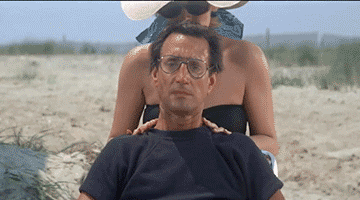The Filmmaker’s Handbook: What is a dolly zoom?
Quick Answer: Associated with Alfred Hitchcock and a famous sequence from Jaws, the dolly zoom is a carefully used and striking technique that combines a zoom in one direction with a simultaneous tracking movement in the other direction.
Certain cinematic techniques manage to become trademarks for certain directors. For instance, Tarantino has the “trunk shot,” and Paul Thomas Anderson loves his whip pans. A particularly disorienting shot known as the dolly zoom is a tactic in which a camera dolly moves one way while the lens is zoomed the other way.
When correctly utilized, the zoom forces the subject of a frame to remain a static size while the foreground and background expand or contract to overwhelm the frame, depending on the movement of the dolly. It undermines normal visual perception and leads to a startling effect. This can make for a big emotional payoff if done properly and at the right moment. In a way, it transforms a three-dimensional image into a two-dimensional image.
The technique has a few other names, including a trombone shot and the Hitchcock Zoom. This is because the trick was made famous by Hitchcock through its super-successful application in the movie Vertigo (1958). Legend says Hitchcock fainted at a party and got the idea for the zoom. Whether that’s true or not is debatable, but cinematographer Irmin Roberts used it in Vertigo and gave birth to the technique as we know it today. Prior to 1958, the shot wasn’t all that possible; it requires smooth mechanics to pull off and the technology wasn’t in place yet to make the shot happen. But Vertigo was the perfect use for the trick, as a feeling of vertigo (or a sense of falling away from oneself) is exactly what the motion produces.
Filmmaker IQ elaborates, “By bending the light we introduce a phenomenon called perspective distortion which is the warping of objects based on the distance from the camera. Perspective distortion does not change by simply increasing or decreasing the focal length or zoom. If you sit in one spot and zoom in you won’t notice and shifting of perspective. But it does change based on the relative position of the camera to the subject.”
This video illustrates nearly every example of the dolly zoom in popular film:
This video discusses how and when to properly use a dolly zoom for the greatest impact:
As those videos illustrate, the dolly zoom has been used in many pictures throughout the years. The one from Jaws (1975) may be the most famous post-Vertigo shot, isolating Chief Brody (Roy Scheider) as he realizes his worst fears.

The dolly zoom is a more challenging feat than it appears, but the proper execution of this creative trick can render a powerful visual effect.

